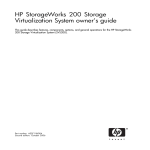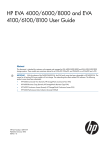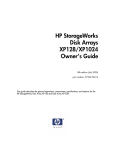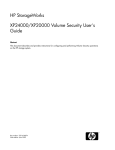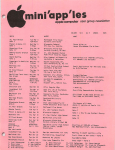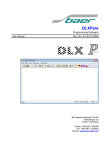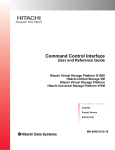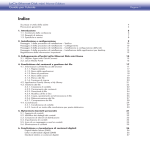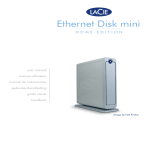Download HP XP20000 Owner's Manual
Transcript
HP StorageWorks XP24000/XP20000 Disk Array Owner Guide Abstract This guide describes the operation of the HP StorageWorks XP24000/XP20000 Disk Arrays. Topics include a description of the disk array hardware, instructions on how to manage the disk array, descriptions of the disk array control panel and LED indicators, troubleshooting, and regulatory statements. The intended audience is a storage system administrator or authorized service provider with independent knowledge of HP StorageWorks XP storage systems and Remote Web Console. Part Number: AE131-96081 Fifth edition: October 2010 Legal and notice information © Copyright 2008, 2010 Hewlett-Packard Development Company, L.P. Confidential computer software. Valid license from HP required for possession, use or copying. Consistent with FAR 12.211 and 12.212, Commercial Computer Software, Computer Software Documentation, and Technical Data for Commercial Items are licensed to the U.S. Government under vendor's standard commercial license. The information contained herein is subject to change without notice. The only warranties for HP products and services are set forth in the express warranty statements accompanying such products and services. Nothing herein should be construed as constituting an additional warranty. HP shall not be liable for technical or editorial errors or omissions contained herein. Warranty WARRANTY STATEMENT: To obtain a copy of the warranty for this product, see the warranty information website: http://www.hp.com/go/storagewarranty Acknowledgments Microsoft, Windows, Windows XP, and Windows NT are U.S. registered trademarks of Microsoft Corporation. Java is a US trademark of Sun Microsystems, Inc. UNIX is a registered trademark of The Open Group. Contents 1 Overview of the HP XP24000/XP20000 Disk Array ............................... 7 Outstanding performance, capacity, and reliability ......................................................................... 7 Continuous data availability ......................................................................................................... 7 Nondisruptive service and upgrades ............................................................................................. 8 Connectivity ............................................................................................................................... 8 Scalability ................................................................................................................................. 9 XP24000 basic configuration ................................................................................................. 9 XP20000 basic configuration ................................................................................................ 9 Adding storage ........................................................................................................... 10 Primary rack expansion ................................................................................................ 10 Secondary rack expansion ............................................................................................ 10 Flexibility ................................................................................................................................. 10 Data encryption ........................................................................................................................ 10 HP XP24000/XP20000 product contents ..................................................................................... 10 Web-based array management ............................................................................................ 11 Operating systems .............................................................................................................. 11 External storage ................................................................................................................. 11 Included components .......................................................................................................... 11 Required additional components .......................................................................................... 12 Software .................................................................................................................................. 12 2 Hardware description of the HP XP24000/XP20000 Disk Array ............ 19 XP24000 system architecture ...................................................................................................... XP20000 system architecture ...................................................................................................... Physical assemblies ................................................................................................................... Disk control frame ..................................................................................................................... DKC clusters ...................................................................................................................... Unit emergency power off switch .......................................................................................... Service Processor (SVP) ....................................................................................................... Disk array frames ...................................................................................................................... Disk drives ............................................................................................................................... RAID options ..................................................................................................................... Backup batteries ....................................................................................................................... Operating specifications ............................................................................................................ XP24000/XP20000 hardware specifications ......................................................................... Temperature specifications ................................................................................................... Humidity specifications ....................................................................................................... Mechanical vibration specifications ...................................................................................... XP24000/XP20000 AC line voltage requirements .................................................................. 19 20 21 22 22 23 23 23 23 24 25 26 26 29 29 30 30 3 Operating the HP XP24000/XP20000 Disk Array ............................... 33 General safety guidelines .......................................................................................................... 33 Managing the disk array ........................................................................................................... 35 Control panel and LED descriptions ............................................................................................. 36 XP24000/XP20000 Disk Array Owner Guide 3 Powering down the disk array .................................................................................................... Planned power off .............................................................................................................. Emergency power off .......................................................................................................... To power off the disk array in an emergency ................................................................... Recovering from an unplanned power outage ............................................................................... Manual restart after power is restored ................................................................................... To restart the disk array manually ................................................................................... Automatic restart when power is restored ............................................................................... 38 39 39 39 40 40 40 41 4 Troubleshooting the HP XP24000/XP20000 Disk Array ........................ 43 Service information messages ..................................................................................................... HP StorageWorks XP Continuous Track (C-Track) ........................................................................... HP Insight Remote Support Advanced .......................................................................................... Failure detection and reporting process ....................................................................................... 43 43 43 45 5 Support and other resources .............................................................. 47 Related documentation .............................................................................................................. HP technical support ................................................................................................................. Customer self repair .................................................................................................................. Rack stability ............................................................................................................................ Subscription service .................................................................................................................. HP websites ............................................................................................................................. Documentation feedback ........................................................................................................... 47 47 47 47 48 48 48 6 Regulatory statements for the HP XP24000/XP20000 Disk Array ........... 49 FCC EMC statement (USA) ......................................................................................................... Notice for the European Union ................................................................................................... IEC statement (worldwide) .......................................................................................................... EMC statement (Canada) ........................................................................................................... Spécification ATI Classe A (France) ............................................................................................. VCCI EMC statement (Japan) ..................................................................................................... BSMI EMC statement (Taiwan) .................................................................................................... RRL EMC statement (Korea) ........................................................................................................ Harmonics conformance (Japan) ................................................................................................. German noise declaration .......................................................................................................... Laser safety .............................................................................................................................. Japan DENAN law cordset caution ............................................................................................. European WEEE statements ........................................................................................................ 49 49 50 50 50 50 50 50 51 51 51 51 52 Glossary ............................................................................................ 57 Index ................................................................................................. 63 4 Figures 1 Disk array simplified SAN connection .......................................................................... 9 2 XP24000 system architecture .................................................................................... 20 3 XP20000 system architecture .................................................................................... 21 4 Disk array frames .................................................................................................... 21 5 Front and rear PCB clusters in the DKC ....................................................................... 22 6 Disk drive installation in the HDU box ........................................................................ 24 7 DKA and HDU interconnections ................................................................................ 24 8 Intermixed RAID groups ........................................................................................... 25 9 Battery de-staging and backup modes ....................................................................... 26 10 Disk array management connections ......................................................................... 35 11 Control panel and LED descriptions ........................................................................... 36 12 Emergency power-off switch location ......................................................................... 39 13 Failure reporting process .......................................................................................... 45 XP24000/XP20000 Disk Array Owner Guide 5 Tables 1 Remote Web Console-based software for XP24000/XP20000 disk arrays ..................... 12 2 Host/Server-based software for the XP24000/XP20000 disk arrays .............................. 15 3 XP Command View Advanced Edition Software for XP24000/XP20000 disk arrays ........ 16 4 XP24000 selected hardware specifications ................................................................. 26 5 XP20000 selected hardware specifications ................................................................ 28 6 XP24000/XP20000 temperature specifications ........................................................... 29 7 XP24000/XP20000 humidity specifications ............................................................... 29 8 XP24000 DKC power specifications for 50-amp, 50 or 60 Hz, single-phase ................... 30 9 XP24000 DKC power specifications for 30-amp, 50 or 60 Hz, single-phase ................... 30 10 XP24000 DKC power specifications for 30-amp, 50 or 60 Hz, three-phase .................... 31 11 XP24000 DKU power specifications for 50-amp, 50 or 60 Hz, single-phase ................... 31 12 XP24000 DKU power specifications for 30-amp, 50 or 60 Hz, single-phase ................... 31 13 XP24000 DKU power specifications for 30-amp, 50 or 60 Hz, three-phase .................... 32 14 XP20000 DKC power specifications for 20-amp, 50 or 60 Hz, single-phase .................. 32 15 XP20000 DKU power specifications for 30-amp, 50 or 60 Hz, single-phase .................. 32 16 Control panel control and LED descriptions ................................................................. 36 17 HP XP24000/XP20000 Disk Array Remote Support Products ....................................... 44 6 1 Overview of the HP XP24000/XP20000 Disk Array This disk array is part of the HP StorageWorks XP series of high-performance RAID-capable disk array systems used to store large quantities of data in an efficient and secure manner. XP disk arrays support multiple operating systems, platforms, and RAID groups. Advantages include: • • • • Continuous data availability Nondisruptive service and upgrades Connectivity Scalability • Data integrity and high availability Outstanding performance, capacity, and reliability The HP StorageWorks XP24000/XP20000 Disk Arrays provide high performance, high capacity, and solid reliability in a large storage system that can start as small as a single frame and expand as your storage needs grow. Coupled with HP's comprehensive customer support, the XP24000/XP20000 disk arrays offer a safe data storage investment that will serve your needs for years to come. Continuous data availability XP disk arrays are designed for nonstop operation and continuous access to all user data. The highest data availability is achieved by the following features: • • • • • • • • • RAID1, RAID5, RAID6 (mixing RAID levels is allowed) Mirrored write cache Dual channel adapters (CHAs) and disk adapters (DKAs) Dual and concurrently active data and control paths through the array Split power domains on internal data paths Hot-pluggable boards Hot-pluggable fans, power supplies, and controllers Online upgradable firmware Remote health and alert monitoring by HP customer support using HP StorageWorks XP Continuous Track software and HP Insight Remote Support Advanced The following optional features ensure the disk array meets your requirements for high availability: • Advanced remote diagnostics • Full solution (host-SAN-storage) support • Full software and solution integration enabled by HP software products XP24000/XP20000 Disk Array Owner Guide 7 NOTE: Although access to data is not compromised, the failure of a key component can cause a temporary reduction in disk array performance. Nondisruptive service and upgrades Without disrupting normal disk array operations (if alternate pathing is used), an HP support representative can: • Remove, service, repair, or replace hardware subassemblies • Use the built-in service processor (SVP) to upgrade microcode • Perform remote error monitoring, diagnosis, and maintenance Alternate paths can be established using host failover software, alternate Fibre Channel paths, or both. CAUTION: The disk array has no user-serviceable components. The SVP does not include a keyboard or monitor and is not a customer-accessible component. Only an HP support representative should open the cabinets. The HP StorageWorks XP C-Track monitoring software and HP Insight Remote Support Advanced product detects problems and automatically reports them to the HP Storage Technology Center (STC). An HP support representative can then verify the problem and perform the appropriate remote maintenance activity with no interruption to applications or hosts. For more information about C-Track, see “HP StorageWorks XP Continuous Track” on page 43. For more information about HP Insight Remote Support Advanced, see “HP Insight Remote Support Advanced” on page 43 Connectivity The system can be configured to provide the following types of host connections: • Fibre Channel: 8 or 16 ports per adapter pair, up to 4 Gbps, SW or LW • ESCON: 8 ports per adapter pair, up to 17 MB • FICON: 8 ports per adapter pair, up to 4 Gbps, SW or LW Figure 1 shows a simple storage area network (SAN) containing an XP24000/XP20000 disk arrays. 8 Overview of the HP XP24000/XP20000 Disk Array Figure 1 Disk array simplified SAN connection . Scalability The disk arrays are scalable to accommodate your current and future storage capacity needs. XP24000 basic configuration The XP24000 configuration consists of a disk control frame (primary rack) that can have 128HDDs and zero to 4 disk array frames (DKU) that can each have 256 HDDs for a total of 1152 hard drives. The disk array provides a flexible configuration that can include: • Number of installed channel options: Channel Adapters (CHAs) 1 to 14 adapters (each DKA set above 4 reduces the maximum number of CHAs by two) • Fibre Channel: up to 224 ports • ESCON: up to 112 ports • FICON: up to 112 ports • Capacity of cache memory: 4 GB to 512 GB • Up to 1152 HDDs Your HP support representative can add DKUs and disk drives online with no interruptions to applications or hosts. XP20000 basic configuration The XP20000 configuration consists of a disk control frame (primary rack) that can have 120 HDDs, and a disk array frame (secondary rack) that can have 120 HDDs. The disk array provides a flexible configuration that can include: • Number of installed channel options: 1 to 3 sets • Capacity of cache memory: 4 GB to 128 GB • Up to 240 HDDs/8 disk paths In the basic configuration, the disk array consists of one primary 19–inch rack containing the following: • One disk controller that consists of the channel adapters, disk adapters, cache memory adapters, shared memory adapters, and CSW • Battery boxes and power supplies that supply power to the components XP24000/XP20000 Disk Array Owner Guide 9 • One 60-disk chassis Adding storage You can add more disk chassis in this order: R0, R1, R2, and R3. Each disk chassis contains 60 hard disk drives. Your HP support representative can add disk chassis and disk drives online with no interruptions to applications or hosts. Additional details about each rack follow. Primary rack expansion In addition to the basic disk chassis R0, you can expand the disk array in the primary rack as follows: • Add 60-disk chassis R1 to the top space of the primary rack. This provides a total of up to 120 drives. Secondary rack expansion You can add a second 19-inch rack with additional disk units as follows: • Add one 60-disk chassis to the second rack for a total of up to 180 drives • Add a second 60-disk chassis to the second rack for a total of up to 240 drives Flexibility The new optional HP StorageWorks XP Thin Provisioning software significantly improves system flexibility while also decreasing storage costs. Using this solution, you begin operation with a global pool of LDEVs that are not assigned to physical storage. The disk arrays add virtual capacity from the pool of LDEVs on the fly as data is written, and only at that time is physical capacity assigned to LDEVs and consumed. Later, if you need additional storage capacity, you can add it without downtime. To create new LDEVS, the system simply continues to use LDEVs from the pool, assigning them to the new physical storage automatically as required. For more information, see the HP StorageWorks XP24000/XP20000 Thin Provisioning User Guide. Data encryption HP StorageWorks DKA Encryption License Key provides physical disk encryption (AES-256) compatible with open and mainframe systems. Encryption can be applied to some or all internal drives with no throughput or latency impacts for data I/O and with little or no disruption to existing applications and infrastructure. HP DKA Encryption License Key includes integrated key management functionality that is both simple and safe to use. For more information, see the HP StorageWorks XP24000/XP20000 Disk Encryption User Guide or contact your HP account representative. HP XP24000/XP20000 product contents The HP XP24000/XP20000 disk array products include hardware, software, services, and support. Some additional components are required and others are optional, as described in this section. For the most current product information, visit the HP website: http://h18006.www1.hp.com/storage/enterprisestorage.html 10 Overview of the HP XP24000/XP20000 Disk Array Web-based array management The XP disk arrays come with HP StorageWorks XP Remote Web Console, a Java-based interface that runs on the SVP and enables you to manage one disk array. For managing multiple arrays, the optional HP StorageWorks XP Command View Advanced Edition software runs on a Windows-based server and can be accessed using remote web-based clients. These software solutions enable comprehensive disk array management. Operating systems The disk arrays support these operating systems: • • • • • • HP-UX Linux Windows Sun Solaris IBM AIX OpenVMS • • • • • Tru64 NonStop VMware Novell NetWare Selected mainframe systems For the latest information on supported operating systems and versions, contact your HP support representative or see the HP StorageWorks Single Point of Connectivity Knowledge (SPOCK) website: http://spock.corp.hp.com/ External storage The XP disk array connects to the following external storage systems and can provide access to and management of external volumes: • HP StorageWorks XP48, XP128, XP256, XP512, XP1024, XP10000, and XP12000 disk arrays • HP StorageWorks Modular Smart Array MSA1000 and MSA1500 • HP StorageWorks EVA3000, EVA4000, EVA 4400, EVA5000, EVA6000, EVA6100, and EVA8000 EVA 8100, disk arrays • Specific disk array models of other manufacturers. Consult your HP representative for details. For more information about HP external storage, see the HP StorageWorks XP24000/XP20000 External Storage Software User Guide. Included components The base XP disk array includes the following hardware, software, services, and support: • • • • One DKC Basic redundant power supplies and backup batteries for base cache and shared memory HP microcode Modem XP24000/XP20000 Disk Array Owner Guide 11 • XP Continuous Track software • Remote Web Console software • An XP Disk Array Documentation CD (includes owner's guide, OS configuration guides, and software user guides) • Site preparation services • Installation and configuration services • Proactive support for one year • Reactive hardware support for two years • Software support for one year (included with software title) Required additional components • • • • • Cache memory Shared memory DKA pairs CHA pairs Hard disk drives • HP StorageWorks XP Array Manager software Software HP offers a full suite of software for the HP StorageWorks XP disk arrays. Sophisticated software packages enable these capabilities so you can take full advantage of the array's power: • • • • • • Manage the disk array configuration Monitor the array performance Optimize your disk array and IT resources Improve overall storage availability Simplify disaster recovery Improve data security Before installing a software package, refer to the software product documentation to verify equipment requirements. To learn more about HP software products, or to obtain software updates, visit the HP website and navigate to XP storage software: http://www.hp.com Table 1 Remote Web Console-based software for XP24000/XP20000 disk arrays Name HP StorageWorks Remote Web Console HP StorageWorks Remote Web Console Error Codes 12 Description Obtains system configuration and status information and sends user-requested commands to the storage systems. Serves as the integrated user interface for all Resource Manager components. Overview of the HP XP24000/XP20000 Disk Array Document HP StorageWorks XP24000/XP20000 Remote Web Console User Guide HP StorageWorks XP24000/XP20000 Remote Web Console Error Codes Name Description Document HP StorageWorks DKA Encryption License Key Enables the user to implement encryption for both open-systems and mainframe data. HP StorageWorks XP24000/XP20000 Disk Encryption User Guide HP StorageWorks XP Thin Provisioning Software Provides “virtual storage capacity” to simplify administration and addition of storage, eliminate application service interruptions, and reduce costs. See the HP StorageWorks XP24000/XP20000 Thin Provisioning Software User Guide. HP StorageWorks XP24000/XP20000 Thin Provisioning Software User Guide HP StorageWorks XP Continuous Access Software Hitachi TrueCopy™ for Mainframe HP StorageWorks XP Business Copy Software Hitachi ShadowImage™ for Mainframe HP StorageWorks XP for FlashCopy Mirroring Software HP StorageWorks XP Continuous Access Journal Software Hitachi Universal Replicator™ for Mainframe Enables the user to perform remote copy operations between storage systems in different locations. TrueCopy provides synchronous and asynchronous copy modes for open-system and mainframe data. Allows the user to create internal copies of volumes for purposes such as application testing and offline backup. Can be used in conjunction with XP Continuous Access to maintain multiple copies of data at primary and secondary sites. HP StorageWorks XP24000/XP20000 Continuous Access Software User Guide Hitachi TrueCopy™ for Mainframe User Guide: HP XP24000 Disk Array, HP XP20000 Disk Array HP StorageWorks XP24000/XP20000 Business Copy Software User Guide Hitachi ShadowImage™ for Mainframe User Guide: HP XP24000 Disk Array, HP XP20000 Disk Array Provides compatibility with the IBM FlashCopy mainframe host software function, which performs server-based data replication for mainframe data. HP StorageWorks XP24000/XP20000 for FlashCopy Mirroring Software User Guide Provides a RAID storage-based hardware solution for disaster recovery which enables fast and accurate system recovery, particularly for large amounts of data which span multiple volumes. Using XP Continuous Access Journal, you can configure and manage highly reliable data replication systems using journal volumes to reduce chances of suspension of copy operations. HP StorageWorks XP24000/XP20000 Continuous Access Journal Software User Guide Hitachi Universal Replicator™ for Mainframe User Guide: HP XP24000 Disk Array, HP XP20000 Disk Array HP StorageWorks XP for Compatible Extended Remote Copy (XRC) Software Provides compatibility with the Extended Remote Copy (XRC) mainframe host software function, which performs server-based asynchronous remote copy operations for mainframe LVIs. HP StorageWorks XP24000/XP20000 for Compatible Extended Remote Copy (XRC) Software User Guide HP StorageWorks XP Snapshot Software Provides ShadowImage functionality using less capacity of the storage system and less time for processing than ShadowImage by using “virtual” secondary volumes. XP Snapshot is useful for copying and managing data in a short time with reduced cost. ShadowImage provides higher data integrity. HP StorageWorks XP24000/XP20000 Snapshot User Guide XP24000/XP20000 Disk Array Owner Guide 13 Name Description Document HP StorageWorks XP External Storage Software Realizes the virtualization of the storage system. Users can connect other storage systems to the XP24000/XP20000 disk array and access the data on the external storage system over virtual devices on the XP24000/XP20000 disk array. Functions such as TrueCopy and Cache Residency can be performed on the external data. HP StorageWorks XP24000/XP20000 External Storage Software User Guide HP StorageWorks XP Disk/Cache Partition Software Provides storage logical partition and cache logical partition: Storage logical partition allows you to divide the available storage among various users to reduce conflicts over usage. Cache logical partition allows you to divide the cache into multiple virtual cache memories to reduce I/O contention. HP StorageWorks XP24000/XP20000 Disk/Cache Partition User Guide HP StorageWorks LUN Manager Enables users to configure the Fibre Channel ports and devices (LUs) for operational environments (for example, arbitrated-loop and fabric topologies, host failover support). The security function allows users to restrict host access to data on the disk arrays. Mainframe users can restrict host access to LVIs based on node IDs and logical partition (LPAR) numbers. HP StorageWorks XP24000/XP20000 LUN Manager User Guide HP StorageWorks SNMP Agent Provides support for SNMP monitoring and management. Enables SNMP-based reporting on status and alerts. SNMP agent on the SVP gathers usage and error information and transfers the information to the SNMP manager on the host. HP StorageWorks XP24000/XP20000 SNMP Agent Reference Guide HP StorageWorks Audit Log Provides detailed records of all operations performed using Remote Web Console (and the SVP). HP StorageWorks XP24000/XP20000 Audit Log User and Reference Guide HP StorageWorks LUN Expansion Allows open-system users to concatenate multiple LUs into single LUs to enable open-system hosts to access the data on the entire storage system using fewer logical units. HP StorageWorks XP24000/XP20000 LUN Expansion User Guide HP StorageWorks Virtual LVI/LUN Enables users to convert single volumes (LVIs or LUs) into multiple smaller volumes to improve data access performance. HP StorageWorks XP24000/XP20000 Virtual LVI/LUN (VLL) and Volume Shredder User Guide HP StorageWorks Cache Residency Manager Allows users to lock and unlock data into cache in real time to optimize access to your most frequently-accessed data. HP StorageWorks XP24000/XP20000 Cache Residency Manager User Guide HP StorageWorks XP for Compatible Parallel Access Volumes Software Enables the mainframe host to issue multiple I/O requests in parallel to single LDEVs in the storage system. Compatible PAV provides compatibility with the IBM Workload Manager (WLM) host software function and supports both static and dynamic PAV functionality. HP StorageWorks XP24000/XP20000 for Compatible Parallel Access Volumes Software User Guide 14 Overview of the HP XP24000/XP20000 Disk Array Name Description Document HP StorageWorks Volume Security Allows users to restrict host access to data on the storage system. Mainframe users can restrict host access to LVIs based on node IDs and logical partition (LPAR) numbers. HP StorageWorks XP24000/XP20000 Volume Security User Guide HP StorageWorks Database Validator Prevents corrupted data environments by identifying and rejecting corrupted data blocks before they are written onto the data drives, thus minimizing risk and potential costs in backup, restore, and recovery operations. HP StorageWorks XP24000/XP20000 Database Validator User Guide HP StorageWorks Data Retention Utility HP StorageWorks XP Volume Retention Manager Allows users to protect data from I/O operations performed by hosts. Users can assign an access attribute to each logical volume to restrict read and/or write operations, preventing unauthorized access to data. HP StorageWorks XP24000/XP20000 Data Retention Utility User Guide HP StorageWorks XP24000/XP20000 Volume Retention Manager User Guide HP StorageWorks Performance Monitor Performs detailed monitoring of storage system and volume activity. HP StorageWorks XP24000/XP20000 Performance Monitor User Guide HP StorageWorks XP Performance Control Software Allows open-system users to designate prioritized ports (for example, for production servers) and non-prioritized ports (for example, for development servers) and set thresholds and upper limits for the I/O activity of these ports. HP StorageWorks XP24000/XP20000 Performance Control User Guide HP StorageWorks Volume Shredder Enables users to overwrite data on logical volumes with dummy data. HP StorageWorks XP24000/XP20000 Virtual LVI/LUN (VLL) and Volume Shredder User Guide Table 2 Host/Server-based software for the XP24000/XP20000 disk arrays Name Description Document XP RAID Manager Enables open-system users to perform data replication and data protection operations by issuing commands from the host to the storage systems. The RAID Manager software supports scripting and provides failover and mutual hot standby functionality in cooperation with host failover products. HP StorageWorks XP RAID Manager User Guide XP for Data Exchange Software Enables users to transfer data between mainframe and open-system platforms using the FICON and/or ESCON channels, for high-speed data transfer without requiring network communication links or tape. HP StorageWorks XP for Data Exchange Software User GuideHP StorageWorks XP for Data Exchange Code Converter User Guide (336pp) Cache Residency Manager Enables users to perform Cache Residency Manager operations from the mainframe host system. Cache Residency Manager allows you to place specific data in cache memory to enable virtually immediate access to this data. HP StorageWorks XP24000/XP20000 Cache Residency Manager User Guide XP24000/XP20000 Disk Array Owner Guide 15 Name Description Document Hitachi Dataset Replication (Logical Volume Divider) Operates together with the XP Business Copy feature. Rewrites the OS management information (VTOC, VVDS, and VTOCIX) and dataset name and creates a user catalog for a XP Business Copy target volume after a split operation. Provides the prepare, volume divide, volume unify, and volume backup functions to enable use of an XP Business Copy target volume. Hitachi Dataset Replication User Guide: Logical Volume Divider Table 3 XP Command View Advanced Edition Software for XP24000/XP20000 disk arrays Name Description Document HP StorageWorks XP Command View Advanced Edition Software Enables users to manage the storage systems and perform functions (e.g., LUN Manager, XP Business Copy) from virtually any location via the Command View Advanced Edition software Device Manager web client, command line interface (CLI), and/or third-party application. HP StorageWorks XP Command View Advanced Edition software Device Manager agent installation and configuration guide HP StorageWorks XP Command View Advanced Edition software server administrator guide for Device Manager and Provisioning Manager HP StorageWorks XP Command View Advanced Edition software quick installation guide HP StorageWorks XP Command View Advanced Edition software Device Manager Help HP StorageWorks XP Command View Advanced Edition software Device Manager Help XP Thin Provisioning Software Designed to handle a variety of storage systems to simplify storage management operations and reduce costs. Works together with Command View Advanced Edition software Device Manager to provide the functionality to integrate, manipulate, and manage storage using provisioning plans. HP StorageWorks XP24000/XP20000 Thin Provisioning Software User Guide XP for Business Continuity Manager Software Enables mainframe users to make Point-inTime (PiT) copies of production data, without interrupting the application or causing any disruption to end-user operations; for such uses as application testing, business intelligence, and disaster recovery for business continuance. HP StorageWorks XP for Business Continuity Manager Software Installation GuideHP StorageWorks XP for Business Continuity Manager Software MessagesHP StorageWorks XP for Business Continuity Manager Software Reference GuideHP StorageWorks XP for Business Continuity Manager Software User Guide HP StorageWorks XP Replication Manager Software Supports management of storage replication (copy pair) operations, enabling users to view (report) the configuration, change the status, and troubleshoot copy pair issues. Replication Manager is particularly effective in environments that include multiple storage systems or multiple physical locations, and in environments in which various types of volume replication functionality (such as XP Business Copy and XP Continuous Access) are used. HP StorageWorks XP Replication Manager Software HelpHP StorageWorks XP Replication Manager software installation and configuration guideHP StorageWorks XP Replication Manager software user guide 16 Overview of the HP XP24000/XP20000 Disk Array Name HP StorageWorks XP Performance Advisor Software Description Document Collects, monitors, and displays in-depth performance data at the component level (LDEV, CHA, DKA, and DKC). Includes XPWatch, a real-time troubleshooting tool to identify the root cause of performance issues. HP StorageWorks XP Performance Advisor Software command-line user interface user guideHP StorageWorks XP Performance Advisor Software installation guideHP StorageWorks XP Performance Advisor Software troubleshooting guideHP StorageWorks XP Performance Advisor Software user guide XP24000/XP20000 Disk Array Owner Guide 17 18 Overview of the HP XP24000/XP20000 Disk Array 2 Hardware description of the HP XP24000/XP20000 Disk Array The HP StorageWorks XP series of disk arrays are high-performance RAID-capable disk array systems used to store large quantities of data in an efficient and secure manner. There are no single points of failure in the disk arrays. They include redundant logic assemblies, controllers, power supplies, and dual-ported RAID disk drives, all of which can be removed or replaced without interrupting access to data. This chapter describes the physical components of the disk array. CAUTION: Only your HP support representative can remove or replace hardware. XP24000 system architecture As Figure 2 shows, the basic XP24000 disk array consists of a DKC cabinet containing two main sections: a logic box and an HDD box. The logic box includes channel adapters (CHA) that provide server and other interfaces, disk adapters (DKA) for controlling disk drives, cache memory adapters (CMA), and shared memory adapters (SMA). The HDD box contains the disk drives and a Fibre switch that interfaces the drives to the DKAs. Additional disk drives can be added by installing up to four optional DKU cabinets containing multiple additional HDD boxes. Components interact by way of the data paths shown in the figure. Also included but not shown in Figure 2 are the AC-DC power supplies and backup batteries. XP24000/XP20000 Disk Array Owner Guide 19 Figure 2 XP24000 system architecture . XP20000 system architecture Figure 3 shows, the basic XP20000 disk array consists of three main sections: the power supply, a DKC, and a DKU. The power supply section consists of the AC-DC power supplies and battery boxes. The DKC consists of the channel adapters (CHAs), disk adapters (DKAs), cache memory adapters (CMAs), and shared memory adapters (SMAs). The DKU consists of the disk drives and Fibre Channel switches (FSW, not shown). Each component is connected with the cache paths, SM paths, and/or disk paths shown in the figure. 20 Hardware description of the HP XP24000/XP20000 Disk Array Figure 3 XP20000 system architecture . Physical assemblies The XP24000 disk array includes the following major hardware assemblies (see Figure 4): • One disk control frame (DKC) • Zero to four disk array frames (DKUs) To monitor and manage the array, a management server supplied by the customer is also required. The following figure shows the disk array with the maximum of four DKUs. The DKC alone constitutes the minimum configuration. Figure 4 Disk array frames . XP24000/XP20000 Disk Array Owner Guide 21 Disk control frame The DKC controls the disk array. It contains the control panel, connection hardware, power supplies, SVP, and control boards for the disk array. It also contains up to 128 disk drives for the XP24000 and contains up to 120 disk drives for the XP20000. DKC clusters As the following figure shows, power and PCBs in the DKC are organized into two independent and redundant clusters. Clustering helps ensure that if power or a PCB associated with one cluster stops operating, the power and PCBs associated with the other cluster can continue to operate and support the disk drives. Cluster 1 consists of the assemblies at the front of the DKC. Cluster 2 consists of the assemblies at the rear. Figure 5 Front and rear PCB clusters in the DKC . 22 Hardware description of the HP XP24000/XP20000 Disk Array Unit emergency power off switch The UNIT EMERGENCY POWER OFF switch is located on the back of the DKC cabinet. For more information about this switch, see “Emergency power off” on page 39. Service Processor (SVP) The Service Processor inside the controller performs these functions: • Collects performance data on the system for diagnostic testing and analysis • Provides your HP support representative with maintenance access to the system • Hosts system management software Your HP support representative uses the SVP to configure, maintain, and upgrade the system software and hardware. The SVP is not a customer-accessible component. To protect your security, the SVP does not have access to any user data stored on array disks. If you have extreme availability requirements, an optional second SVP is available. Disk array frames DKUs are optional cabinets that allow you to expand the disk array's storage capacity. DKUs contain physical disk drives. The disk array can include up to four DKUs. Four DKUs fully populated with disk drives (plus the disk drives in the DKC) provide up to 1152 total hard disk drives for the XP24000 and 240 total hard disk drives for the XP20000. Disk drives The DKC can hold up to 128 hard disk drives for the XP2400 and 120 hard disk drives for the XP20000. Each DKU can contain up to 256 hard disk drives installed on the XP24000 and 240 hard disk drives installed on the XP20000. There can be from zero to four DKU's. The disk array automatically detects and corrects disk errors, and an HP support representative can replace or add disk drives without disrupting user activity. The disk array can contain up to 40 spare disk drives for the XP24000 and 16 spare disk drives on the XP20000. Any of the spare disk drives can back up any other disk drive of equal rotational speed and equal or lesser capacity, in any DKU, even if the failed disk and the spare disk are in different array domains. The XP24000/XP20000 disk arrays support several sizes of Fibre Channel, SATA, and solid state disk drives. Fibre Channel drives are intended as a high-capacity, high-performance storage option for high-priority applications. As shown in Figure 6, disk drives install in the Hard Drive Unit (HDU) boxes mounted in the DKC and DKU frames. Each box holds four groups of 16 drives for the XP24000 and holds four groups of 15 drives for the XP20000. The drives in the HDU connect to the DKA through a Fibre Switch (FSW) and the FC-AL path. The lower drives in an HDU (FSW-L) connect to the DKA pair in Cluster 1, and the upper drives in an HDU connect to the DKA pair in Cluster 2. XP24000/XP20000 Disk Array Owner Guide 23 Figure 6 Disk drive installation in the HDU box . Figure 7 shows how the disk adapters connect to the HDUs in a fully expanded system. Figure 7 DKA and HDU interconnections . RAID options The disk array supports RAID1 (2D+2D or 4D+4D), RAID5 (3D+1P or 7D+1P), and RAID6 (6D+2P) array groups. RAID levels may be intermixed, as illustrated by Figure 8. 24 Hardware description of the HP XP24000/XP20000 Disk Array Figure 8 Intermixed RAID groups . Backup batteries The XP24000/XP20000 disk arrays use batteries and two modes of backup operation to provide backup power protection for cache memory, shared memory, the DKAs, CHAs, and disk drives. If AC input power is lost, the disk array continues normal operation for 200 ms or 1 minute, depending on whether the disk array is set for Backup Mode or De-stage Mode. See Figure 9. If Backup Mode is selected and AC power is lost for more than 200 ms, the disk array enters the Backup Mode, which maintains the contents of cache and shared memory for 36 to 48 hours, depending on the amount of cache memory installed. This mode is the default and the only available mode for the base battery configuration. If De-stage Mode is selected and sufficient optional DKC and DKU backup batteries are installed, the batteries maintain normal operation for 1 minute. After 1 minute without AC power, the disk array executes the De-stage Mode, which saves the contents of cache and shared memory to disk, maintains the contents of cache and shared memory for 16 to 24 hours, and powers down the system. Even if power is restored shortly after one minute, the de-stage and power down processes continue until they are completed. XP24000/XP20000 Disk Array Owner Guide 25 Figure 9 Battery de-staging and backup modes . When AC power is restored, the disk array powers on again automatically if the AUTO POWER-ON jumper is set to ENABLE. If the jumper is set to DISABLE, the disk array must be manually powered on again using the control panel PS ENABLE and PS ON/OFF switches. Before installation HP representatives will help you determine the best battery mode and power-on mode for your configuration and will configure the selected mode for you. Operating specifications This section provides some general specifications. For complete specifications, see the HP StorageWorks Disk Array Site Preparation Guide available on the HP storage manuals website: http://www.hp.com/support/manuals XP24000/XP20000 hardware specifications The following tables provide selected hardware specifications for the XP24000/XP20000 Disk Arrays. For additional specifications, see the HP StorageWorks Disk Array Site Preparation Guide. Table 4 XP24000 selected hardware specifications Feature Specification Power Single-phase, 50 or 60 Hz, or 3-phase DKC/DKU One XP24000 DKC, zero to four XP24000 DKUs Maximum hard disk drives 1152 Maximum spare disk drives 40 Maximum array groups/subsystem 287 26 Hardware description of the HP XP24000/XP20000 Disk Array Feature Maximum storage capacity (not including external storage) Cache Specification 332 TB (where 1 TB = 1012 bytes) (Usable storage is always less than the maximum raw storage capacity.) 4 to 512 GB • 73 GB 15000 RPM FC • 73 GB Solid State • 146 GB 15000 RPM FC • 146 GB Solid State • 200 GB Solid State • 300 GB 10000 RPM FC Hard disk and flash drives • 300 GB 15000 RPM FC • 400 GB Solid State • 750 GB 7200 RPM SATA • 400 GB 10000 RPM FC • 1TB 7.2k SATA Array Group • 450GB 15K RPM HDD • 8 Port 8 GB FC CHA • 8 GB LW Transceiver Shared memory 2 to 32 GB (Available shared memory depends on the configuration) Up to two adapters supporting two DKA pairs (4 DKAs total) per DKU. DKAs are sold in sets of 2 pairs. • 2 DKA pairs = up to 256 HDDs, 16 paths Disk Adapters (DKAs) • 4 DKA pairs = up to 640 HDDs, 32 paths • 6 DKA pairs = up to 768 HDDs, 48 paths • 8 DKA pairs = up to 1152 HDDs, 64 paths 1 to 14 adapters (each DKA set above 4 reduces the maximum number of CHAs by two) Channel Adapters (CHAs) • Fibre Channel: up to 224 ports • ESCON: up to 112 ports • FICON: up to 112 ports Configuration disk XP24000-specific SVP code XP24000-specific High-availability secondary SVP Optionally available • RAID1 (2D+2D) • RAID1 (4D+4D) RAID level • RAID5 (3D+1P) • RAID5 (7D+1P) • RAID6 (6D+2P) LDEVs Up to 64K XP24000/XP20000 Disk Array Owner Guide 27 Feature Specification LUNs per port Up to 1024 Table 5 XP20000 selected hardware specifications Feature Specification Power Single-phase, 50 or 60 Hz DKC/DKU One XP20000 DKC, zero to one XP20000 DKU Maximum hard disk drives 240 Maximum spare disk drives 16 Maximum array groups/subsystem 287 Maximum storage capacity (excluding external storage) Cache 69.2 TB (where 1 TB = 1012 bytes) (Usable storage is always less than the maximum raw storage capacity.) 4 to 128 GB • 73 GB 15000 RPM FC • 73 GB Solid State • 146 GB 15000 RPM FC • 146 GB Solid State • 200 GB Solid State • 300GB 10000 RPM HDD Available hard disk drives • 300 GB 10000 RPM or 15,000 RPM FC • 400 GB 10,000 RPM or 15,000 RPM FC • 400 GB Solid State • 750 GB 7200 RPM SATA • 1TB 7.2k SATA Array Group • 450GB 15000 RPM HDD • 600 GB 15K FC HDD • 2TB 7.2K HDD Shared memory 2 to 16 GB (Available shared memory depends on the configuration) Disk Adapters (DKAs) Up to two adapters supporting two DKA pairs (4 DKAs total) per DKU. DKAs are sold in sets of 2 pairs. • 1 DKA pair = up to 240 HDDs 1 to 6 adapters (each DKA set above 4 reduces the maximum number of CHAs by two) Channel Adapters (CHAs) • Fibre Channel: up to 48 ports • ESCON: up to 24 ports • FICON: up to 24 ports Configuration disk 28 XP20000-specific Hardware description of the HP XP24000/XP20000 Disk Array Feature Specification SVP code XP20000-specific High-availability secondary SVP Optionally available • RAID1 (2D+2D) • RAID1 (4D+4D) RAID level • RAID5 (3D+1P) • RAID5 (7D+1P) • RAID6 (6D+2P) LDEVs Up to 64K LUNs per port Up to 1024 Temperature specifications Table 6 XP24000/XP20000 temperature specifications Temperature range type Range Recommended operating temperature range 21 to 24 degrees C, 70 to 75 degrees F Operating temperature 16 to 32 degrees C, 61 to 89 degrees F Nonoperating temperature range –10 to +43 degrees C, 14 to 109 degrees F Shipping and storage temperature (product packed in factory packing) –25 to +60 degrees C, –13 to +140 degrees F Temperature shock immunity (maximum rate of temperature change) 10 degrees C per hour, 18 degrees F per hour Over-temperature warning At 40 degrees C, 104 degrees F Over-temperature shutdown At 60 degrees C, 140 degrees F Humidity specifications Protect the disk array from excessive humidity. You should not observe condensation in or around the product under any conditions. There is no procedure for recovery from moisture condensation. Table 7 XP24000/XP20000 humidity specifications Humidity range type Noncondensing relative humidity (RH) Recommended operating humidity range at 22 degrees C (71 degrees F) 50% to 55% Operating humidity range at 22 degrees C (71 F) 20% to 80% Nonoperating humidity range 8% to 90% XP24000/XP20000 Disk Array Owner Guide 29 Humidity range type Noncondensing relative humidity (RH) Shipping and storage humidity range (product packed in factory packing) 5% to 95% Mechanical vibration specifications Maximum operating acceleration is 0.05G at a frequency range of 10 to 300 Hz. XP24000/XP20000 AC line voltage requirements Each DKC or DKU has two or four power cords. In case of a failure of the power source for one cord, the power requirements, and therefore the current requirement for the remaining power cord, will double. For details about cabling and connectors, current requirements, and other electrical specifications, see the HP StorageWorks XP24000/XP20000 Disk Array Site Preparation Guide. Table 8 XP24000 DKC power specifications for 50-amp, 50 or 60 Hz, single-phase Parameter Number of power cords Recommended circuit breakers Number of circuit breakers 200 VAC 50/60 Hz 208 VAC 60 Hz 220 VAC 50 Hz 230 VAC 50/60 Hz 240 VAC 50 Hz 2 2 2 2 2 50A 50A 50A 50A 50A 2 2 2 2 2 Table 9 XP24000 DKC power specifications for 30-amp, 50 or 60 Hz, single-phase Parameter Number of power cords Recommended circuit breakers 30 200 VAC 50/60 Hz 208 VAC 60 Hz 220 VAC 50 Hz 230 VAC 50/60 Hz 240 VAC 50 Hz 4 4 4 4 4 30A 30A 30A 30A 30A Hardware description of the HP XP24000/XP20000 Disk Array Parameter Number of circuit breakers 200 VAC 50/60 Hz 208 VAC 60 Hz 220 VAC 50 Hz 230 VAC 50/60 Hz 240 VAC 50 Hz 4 4 4 4 4 Table 10 XP24000 DKC power specifications for 30-amp, 50 or 60 Hz, three-phase Parameter Number of power cords Recommended circuit breakers Number of circuit breakers 200 VAC 50/60 Hz 208 VAC 60 Hz 220 VAC 50 Hz 230 VAC 50/60 Hz 240 VAC 50 Hz 380 VAC 50 Hz 400 VAC 50 Hz 415 VAC 50 Hz 2 2 2 2 2 2 2 2 30A 30A 30A 30A 30A 30A 30A 30A 2 2 2 2 2 2 2 2 Table 11 XP24000 DKU power specifications for 50-amp, 50 or 60 Hz, single-phase Parameter Number of power cords Recommended circuit breakers Number of circuit breakers 200 VAC 50/60 Hz 208 VAC 60 Hz 220 VAC 50 Hz 230 VAC 50/60 Hz 240 VAC 50 Hz 2 2 2 2 2 50A 50A 50A 50A 50A 2 2 2 2 2 Table 12 XP24000 DKU power specifications for 30-amp, 50 or 60 Hz, single-phase Parameter Number of power cords Recommended circuit breakers 200 VAC 50/60 Hz 208 VAC 60 Hz 220 VAC 50 Hz 230 VAC 50/60 Hz 240 VAC 50 Hz 4 4 4 4 4 30A 30A 30A 30A 30A XP24000/XP20000 Disk Array Owner Guide 31 Parameter Number of circuit breakers 200 VAC 50/60 Hz 208 VAC 60 Hz 220 VAC 50 Hz 230 VAC 50/60 Hz 240 VAC 50 Hz 4 4 4 4 4 Table 13 XP24000 DKU power specifications for 30-amp, 50 or 60 Hz, three-phase Parameter Number of power cords Recommended circuit breakers Number of circuit breakers 200 VAC 50/60 Hz 208 VAC 60 Hz 220 VAC 50 Hz 230 VAC 50/60 Hz 240 VAC 50 Hz 380 VAC 50 Hz 400 VAC 50 Hz 415 VAC 50 Hz 2 2 2 2 2 2 2 2 30A 30A 30A 30A 30A 30A 30A 30A 2 2 2 2 2 2 2 2 Table 14 XP20000 DKC power specifications for 20-amp, 50 or 60 Hz, single-phase Parameter Number of power cords Recommended circuit breakers Number of circuit breakers 200 VAC 50/60 Hz 208 VAC 60 Hz 220 VAC 50 Hz 230 VAC 50/60 Hz 240 VAC 50 Hz 4 4 4 4 4 20A 20A 20A 20A 20A 4 4 4 4 4 Table 15 XP20000 DKU power specifications for 30-amp, 50 or 60 Hz, single-phase Parameter Number of power cords Recommended circuit breakers Number of circuit breakers 32 200 VAC 50/60 Hz 208 VAC 60 Hz 220 VAC 50 Hz 230 VAC 50/60 Hz 240 VAC 50 Hz 4 4 4 4 4 30A 30A 30A 30A 30A 4 4 4 4 4 Hardware description of the HP XP24000/XP20000 Disk Array 3 Operating the HP XP24000/XP20000 Disk Array During normal operations, the disk array does not require your intervention and you should not attempt to open the disk array cabinets. The disk array reports any service information messages (SIMs) to the SVP and the Device Manager server. If the array is set up for remote support using either the modem or Internet option, the SVP automatically reports SIMs to the HP Storage Technology Center (STC). For more information about SIMs and the remote support capabilities, including the modem-based and Internet-based options, see “HP StorageWorks XP Continuous Track” on page 43, and also “Failure detection and reporting process” on page 45. General safety guidelines Carefully read these safety guidelines and follow them when working with the disk array. • Fully understand and follow all hazard warnings in this guide and on warning labels on the disk array. These hazard warnings help you to prevent or reduce the risk of death, personal injury, or product damage. Hazard warnings include alert headings consisting of an alert symbol and the word Caution or Warning. CAUTION: This indicates a hazardous situation which, if not avoided, will or can result in serious product damage or loss of data. WARNING! This indicates a potentially hazardous situation which, if not avoided, can result in death or serious injury. • Replace any warning label that becomes dirty or starts peeling off. • Keep in mind that the hazard warnings in this guide and on the disk array cannot cover every possible hazard because it is impossible to predict and evaluate all potentially hazardous circumstances. Be alert and use common sense. If you have any questions, contact your HP support representative. • Follow the safety guidelines and procedures in all documentation for this and related products. XP24000/XP20000 Disk Array Owner Guide 33 CAUTION: Disk array maintenance must be done only by trained and qualified HP support representatives. Only an HP support representative can power off the disk array, except in an emergency. CAUTION: Do not perform any procedures not described in this guide. If you have any questions or concerns, contact your HP support representative. WARNING! Do not touch areas marked HAZARDOUS, even with the power off. These areas contain high-voltage power. CAUTION: If you detect any abnormal noise, smell, or smoke coming from the disk array, immediately power off the disk array by following the emergency power off procedure later in this chapter. For routine power off in non-emergency situations, contact your HP support representative. CAUTION: Do not power off the system unless it is an emergency situation and you follow the procedure for Emergency power off. CAUTION: Keep the front and rear doors closed at all times. CAUTION: Keep the tops and sides of the cabinets clear to allow air to flow properly. CAUTION: Use the supplied power cord. The power cord may not be used with other products. 34 Operating the HP XP24000/XP20000 Disk Array Managing the disk array The Remote Web Console software allows browser-based management of a single disk array. You can install the optional HP StorageWorks XP Array Manager software and the HP StorageWorks Command View XP Advanced Edition software on an optional management server to enable additional management capabilities, including the ability to manage multiple arrays. You can also install other HP StorageWorks XP Disk Array software on the management server. You may use an existing host (such as your storage administrator's PC) as the management server provided that it meets system requirements for the software you plan to deploy. To protect your security, the disk array management software does not have access to user data stored on the disk array. The management server connects to the disk array(s) using an Ethernet LAN connection, as shown in Figure 10. Figure 10 Disk array management connections . 1. Host computer 2. Host connection (Fibre Channel or other connection type) 3. DKC 4. Ethernet LAN 5. Management server XP24000/XP20000 Disk Array Owner Guide 35 Control panel and LED descriptions Once the disk array is powered on and running normally, no user operations are required at the control panel, except when you are instructed by your HP support representative. Figure 11 shows the control panel location and layout. Table 16 explains the control panel functions. Figure 11 Control panel and LED descriptions . Table 16 Control panel control and LED descriptions Item Label Indicator Description During normal operation, this LED should be on. 1 SUB-SYSTEM READY LED (Green) • ON: Input/output operation on the channel interface is enabled. • OFF: The system is not accepting data. 36 Operating the HP XP24000/XP20000 Disk Array Item Label Indicator Description During normal operation, this LED should be off. • ON: One or more of the following: • DKC DC power is under voltage. • DC power is over current. 2 SUB-SYSTEM ALARM • The temperature is abnormally high. LED (Red) • An unrecoverable failure has occurred. If the disk array is set up for remote support, your HP support representative is notified automatically. If the disk array is not set up for remote support, place a service call to HP to have the message evaluated to determine if any action is required. • BLINKING: DKU DC power is under voltage. During normal operation, this LED should be off. 3 SUB-SYSTEM MESSAGE LED (Amber) • ON: A service information message (SIM) has been issued from either storage cluster. If the disk array is set up for remote support, your HP support representative is notified automatically. If the disk array is not set up for remote support, place a service call to HP to have the message evaluated to determine if any action is required. • BLINKING: An SVP failure has occurred. The disk array will continue to operate normally. Place a service call to HP to ensure notification. SVP failures may not be reported automatically to STC. 4 5 6 SUB-SYSTEM RESTART REMOTE MAINTENANCE PROCESSING REMOTE MAINTENANCE ENABLE/DISABLE Switch LED (Amber) Used to recover from a FICON/ESCON port failure. Do not change the switch position unless directed to do so by HP service personnel. During normal operation, this LED may be on if remote maintenance is allowed (the REMOTE MAINTENANCE ENABLE/DISABLE switch is in the ENABLE position). • ON: Remote maintenance is in progress. An HP support representative is probably working on the system, but the system is online and accepting data. Used to permit remote service maintenance. During normal operation, this switch should be in the ENABLE position. Switch • DISABLE: Remote maintenance is disabled. • ENABLE: An HP support representative can perform remote maintenance. Do not change the switch position unless directed to do so by HP service personnel. During normal operation, this LED should be on. 7 EMERGENCY LED (Red) • ON: The UNIT EMERGENCY POWER OFF switch on the back of the disk array cabinet is in the ON position. • OFF: The UNIT EMERGENCY POWER OFF switch is in the OFF position. Place a service call to HP to have an HP support representative reset the switch. XP24000/XP20000 Disk Array Owner Guide 37 Item Label Indicator Description During normal operation, this LED should be on. 8 BS-ON LED (Amber) • ON: The disk array is plugged in and receiving power from the primary AC outlet. The SVP is receiving power from the outlet. • OFF: The disk array is not receiving power from the primary AC outlet. Check the electrical outlets in your building. During normal operation, this LED should be on. 9 PS-ON LED (Green) • ON: The PS ON/OFF switch is on. If the SUB-SYSTEM READY light (1) is also on, the disk array is ready to receive data. • OFF: The PS ON/OFF switch is off and the disk array is not ready to receive data. Used to enable the PS ON/OFF switch (11). During normal operation, this switch should be in the “Disable” position (opposite the ENABLE position). 10 PS ENABLE Switch • ENABLE: The PS ON/OFF switch can be used. • DISABLE: The PS ON/OFF switch cannot be used. Do not change the switch position unless directed to do so by HP service personnel. Used to power on/off the disk array. During normal operation, this switch should be in the ON position. The switch functions only if: 11 PS ON/OFF Switch the PS ENABLE switch (10) is in the ENABLE position, AND the PS REMOTE/LOCAL switch (12) is in the LOCAL position. Do not change the switch position unless directed to do so by HP service personnel. Determines how the disk array is powered on or off. During normal operation, this switch may be in either position, depending on your operating environment. 12 PS REMOTE/LOCAL Switch • REMOTE: Disk array is powered on/off by the instructions of the host PCI (mainframe only). • LOCAL: Disk array is powered on/off by the PS ON/OFF switch (11). Do not change the switch position unless directed to do so by HP service personnel. 13 CHK RST Switch Used by an HP support representative to test the functioning of the LEDs on the control panel or to reset alarms. Do not change the switch position unless directed to do so by HP service personnel. Powering down the disk array Two situations may arise when you need to power down the system: • Planned power off • Emergency power off 38 Operating the HP XP24000/XP20000 Disk Array Planned power off Occasionally, you may need to plan a site power outage, such as during alterations to the data center, inspections, or work by the electric company. If a scheduled power outage will affect the disk array, contact your HP support representative to schedule a planned power off. CAUTION: Only a trained HP support representative can shut down and power off the disk array. Do not attempt to power down the disk array other than during an emergency. Emergency power off In an emergency, it is critical to remove power to the disk array as quickly as possible. CAUTION: Performing the emergency power off procedure immediately shuts down the disk array, neglecting the array's normal power off sequence. Jobs in process are aborted and their integrity after recovery is not guaranteed. Use this power off method only in an emergency. Only a qualified HP support representative can reset the switch and restore power to the disk array. Emergency situations in which you should consider performing the emergency power off procedure are: • A physical location catastrophe such as a flood, hurricane, tornado, or earthquake • Any circumstance that presents the threat of injury or death to a person • You detect any smoke, abnormal loud noise, or smell coming from the disk array To power off the disk array in an emergency 1. Locate the UNIT EMERGENCY POWER OFF switch on the back side of the DKC, as shown in Figure 12. Figure 12 Emergency power-off switch location . XP24000/XP20000 Disk Array Owner Guide 39 2. Pull the switch up and then out towards you. The disk array shuts down immediately. The UNIT EMERGENCY POWER OFF switch mechanically locks itself in the off position to prevent anyone from restoring power in a potentially hazardous situation. WARNING! The UNIT EMERGENCY POWER OFF switch provides only partial power off capability. AC input power remains present at the primary circuit. 3. When the emergency situation is over, call the HP technical support center. Only a qualified HP support representative can reset the switch and restore power to the disk array. Recovering from an unplanned power outage Unplanned power outages occur when the primary building power is lost due to electrical blackouts, thunderstorm activity, or similar occurrences, and input AC power is not received by the disk array. The disk array will maintain its state and recover when power is restored. The disk array cache is powered by backup batteries that will maintain the array state for up to 48 hours, depending on the selected battery operation mode. For more information, see “Backup batteries” on page 25. Manual restart after power is restored CAUTION: After power is restored to your site and before restoring power to the disk array, HP recommends that you have an electrician verify the power to ensure that all phases are restored and input power to the disk is stable. Contact your HP representative for help recovering from a power outage. To restart the disk array manually 1. 40 Move the PS ENABLE switch to the ENABLE position. Operating the HP XP24000/XP20000 Disk Array 2. Move the PS ON/OFF switch to the ON position. The following LED power sequence occurs: • BS-ON turns amber. • PS-ON turns green. • SUB-SYSTEM MESSAGE may turn amber if the disk array is not configured for remote support. This indicates the system has produced a service information message because of the power outage. • SUB-SYSTEM READY turns green, signifying the system is ready. CAUTION: Powering on the disk array can take up to 10 minutes and is complete only when the SUB-SYSTEM READY LED turns green. 3. Move the PS ENABLE switch to “DISABLE” (opposite ENABLE). Automatic restart when power is restored CAUTION: As with all sophisticated electronic equipment, unstable power conditions during a restart can cause problems. HP recommends automatic power on restart only if the power to the disk array is subject to power conditioning equipment, such as an uninterruptible power supply (UPS), to ensure that the power restored to the disk array is stable. If your site does not have a UPS, HP recommends that the disk array be configured for manual restart, meaning the POWER ENABLE switch on the control panel is in the DISABLE position. After a power outage, follow the manual restart procedure only after power has been restored and verified stable. With automatic restart enabled, the disk array automatically restarts and returns to service when power is restored. During the automatic restart, the following LED power sequence occurs: • BS-ON turns amber. • PS-ON turns green. • SUB-SYSTEM MESSAGE may turn amber if the disk array is not configured for remote support. This indicates the system has produced a service information message because of the power outage. • SUB-SYSTEM READY turns green, signifying the system is ready. CAUTION: Powering on the disk array can take up to 10 minutes and is complete only when the SUB-SYSTEM READY LED turns green. To enable automatic restart: • Move the AUTO PS-ON ENABLE/DISABLE switch to the ENABLE position. XP24000/XP20000 Disk Array Owner Guide 41 42 Operating the HP XP24000/XP20000 Disk Array 4 Troubleshooting the HP XP24000/XP20000 Disk Array Service information messages The system generates service information messages (SIMs) to identify normal operations, service requirements, and failures. SIMs are generated by the SVP and the system microprocessors. Your HP support representative uses the SIMs to monitor and troubleshoot the system as explained below. You can view SIMs using the system's management software. HP StorageWorks XP Continuous Track (C-Track) The HP StorageWorks XP Continuous Track (C-Track) remote support solution detects and reports system problems to the HP Storage Technology Centers (STCs). C-Track transmits heartbeats, system information messages (SIMs), and configuration information for remote data collection and monitoring purposes. C-Track also enables the STCs to remotely diagnose issues and perform maintenance, if you permit remote device access (RDA). The C-Track solution offers an Internet connectivity option for the XP24000/XP20000 disk arrays in addition to a modem connectivity option. The C-Track solution offers an Internet connectivity option for the XP24000/XP20000 disk arrays in addition to a modem connectivity option. If you choose the Internet-based remote support solution, additional infrastructure and site preparation are required. This additional preparation may include server and router requirements, and HP and the customer may both have implementation responsibilities. For more information about the C-Track Internet-based solution, ask your HP representative. If you use the modem connectivity option, you can disable C-Track remote diagnosis and maintenance by setting the Remote Maintenance Enable/Disable switch to the Disable position. When the switch is in this position, HP technical support cannot perform remote disk array maintenance. However, the C-Track remote data collection and monitoring functions remain enabled. If you use the Internet connectivity option, you can disable remote diagnosis and maintenance by configuring the Customer Access System (CAS) component of the solution to prevent external login by HP support personnel. The Remote Maintenance Enable/Disable switch position is irrelevant for the Internet connectivity option, and the C-Track remote data collection and monitoring functions remain enabled even though remote diagnosis and maintenance are disabled. By implementing certain configuration settings, HP can disable remote data collection and monitoring, or remote diagnosis and maintenance, or both. HP Insight Remote Support Advanced HP strongly recommends that you install HP Insight Remote Support software to complete the installation or upgrade of your product and to enable enhanced delivery of your HP Warranty, HP Care Pack Service or HP contractual support agreement. HP Insight Remote Support supplements your monitoring, XP24000/XP20000 Disk Array Owner Guide 43 24x7 to ensure maximum system availability by providing intelligent event diagnosis, and automatic, secure submission of hardware event notifications to HP, which will initiate a fast and accurate resolution, based on your product’s service level. Notifications may be sent to your authorized HP Channel Partner for on-site service, if configured and available in your country. The HP Insight Remote Support products available for the XP24000/XP20000 disk arrays are described in Table 17 on page 44. NOTE: HP Insight Remote Support Standard is not supported on XP Disk Arrays. Table 17 HP XP24000/XP20000 Disk Array Remote Support Products HP Product Description Application AE241A HP XP Remote Device Access w/LAN Support (Recommended) For customers that fully commit to use HP Remote Support. It uses HP Insight Remote Support for XP Remote Device Monitoring utilizing LAN/Internet connectivity and Remote Device Access Support. This configuration is required to meet the objectives of XP disk array’s Internet connectivity with Remote Device Access initiative and prerequisites for Critical Support contracts. HP recommends that the AE241A product with Internet connectivity should be utilized for all new XP installations, to ensure the optimal support model and highest TCE. AE242A HP XP No Remote Device Access w/LAN Supp (Default) For customers that commit to utilize Internet and Insight Remote Support connectivity for XP Remote Device Monitoring but will not allow for Remote Device Access to the XP array from HP for proactive and critical support processes. With no Remote Device Access, Critical Support contract prerequisites cannot be met. HP XP Modem Remote Support For customers that will commit to utilize remote support connectivity via modem rather than LAN/Internet connectivity. Modem is older technology that is significantly less reliable than LAN/Internet connectivity, is less capable, does not support some features for Remote Device Access, and generally should not be considered for new installations. The AE243A product is only allowed for customers that have valid reasons for not using Internet connectivity. The initial cost of this configuration only covers the additional warranty support cost to HP during warranty period. Other additional costs can also be incurred for support contracts for customers who do not have LAN configured. Factory Authorization will be required to order this product. Proof of a valid reason that Internet connectivity is not allowed must be provided for Factory Authorization approval. HP XP Mission Critical No LAN Support For a customer whose strict security protocols specifically prohibit inbound/ outbound traffic to/from the data center and thus will not allow Remote Support connection by either modem or LAN/internet connectivity; but does have Mission Critical Services with Customer Engineer onsite included in the terms of the support contract. Factory Authorization will be required to order this product. Proof of valid Customer Engineer onsite Mission Critical support contract must be provided for Factory Authorization approval. AE243A AE244A 44 Troubleshooting the HP XP24000/XP20000 Disk Array HP Product AE245A Description Application HP XP No Mission Critical No LAN Support For a customer whose strict security protocols specifically prohibit inbound/ outbound traffic to/from the data center and thus will not allow Remote Support connection by either modem or LAN and does not have a Mission Critical Services on-site contract. The added cost of this configuration only covers the additional warranty support cost to HP during warranty period. Other additional costs can also be incurred for support contracts for customers who do not have remote support configured. Details for both versions are available at: http://www.hp.com/go/insightremotesupport To download the software, go to Software Depot: http://www.software.hp.com Select Insight Remote Support from the menu on the right. Failure detection and reporting process If a failure occurs in the system, the failure is detected and reported to the system log, the SIM log, and HP technical support, as shown in Figure 13. Figure 13 Failure reporting process . 1. A failure is detected in the system. XP24000/XP20000 Disk Array Owner Guide 45 2. The failure is reported to the system. 3. The system stores the failure information in the system log. 4. The generated SIMs are stored on the system for use by HP technical support representatives, and logged on the management server as remote SIMs (R-SIMs). If the system is not set up for remote support, when a SIM is generated, the amber message LED on the system control panel turns on. Call HP to determine the reason for the message. 5. If the system is set up for remote support, C-Track reports the SIMs to HP technical support through a dedicated dialup or secure Internet connection. SIMs are classified according to severity: service, moderate, serious, or acute. Service and moderate levels do not require immediate attention and are addressed during routine maintenance. These failures are often corrected before the failure becomes apparent. Serious and acute levels are reported immediately to HP support to ensure that the problem is addressed as soon as possible. 46 Troubleshooting the HP XP24000/XP20000 Disk Array 5 Support and other resources Related documentation The following documents provide related information: • HP StorageWorks XP24000/XP20000 Disk Array Site Preparation Guide • HP StorageWorks XP24000/XP20000 Remote Web Console User Guide • HP StorageWorks XP Disk Array Mainframe Host Attachment and Operations Guide You can find these documents on the HP Manuals website: http://www.hp.com/support/manuals In the Storage section, click Disk Storage Systems and then select a product. HP technical support For worldwide technical support information, see the HP support website: http://www.hp.com/support Before contacting HP, collect the following information: • • • • • • Product model names and numbers Technical support registration number (if applicable) Product serial numbers Error messages Operating system type and revision level Detailed questions Customer self repair HP customer self repair (CSR) programs allow you to repair your StorageWorks product. If a CSR part needs replacing, HP ships the part directly to you so that you can install it at your convenience. Some parts do not qualify for CSR. Your HP-authorized service provider will determine whether a repair can be accomplished by CSR. For more information about CSR, contact your local service provider. For North America, see the CSR website: http://www.hp.com/go/selfrepair This product has no customer replaceable components. Rack stability Rack stability protects personnel and equipment. XP24000/XP20000 Disk Array Owner Guide 47 WARNING! To reduce the risk of personal injury or damage to equipment: • • • • • Extend leveling jacks to the floor. Ensure that the full weight of the rack rests on the leveling jacks. Install stabilizing feet on the rack. In multiple-rack installations, fasten racks together securely. Extend only one rack component at a time. Racks can become unstable if more than one component is extended. Subscription service HP recommends that you register your product at the Subscriber's Choice for Business website: http://www.hp.com/go/e-updates After registering, you will receive email notification of product enhancements, new driver versions, firmware updates, and other product resources. HP websites For additional information, see the following HP websites: • • • • http://www.hp.com http://www.hp.com/go/storage http://www.hp.com/support/manuals http://www.hp.com/storage/spock Documentation feedback HP welcomes your feedback. To make comments and suggestions about product documentation, please send a message to [email protected]. All submissions become the property of HP. 48 Support and other resources 6 Regulatory statements for the HP XP24000/XP20000 Disk Array FCC EMC statement (USA) This equipment has been tested and found to comply with the limits for a Class A digital device, pursuant to Part 15 of the FCC rules. These limits are designed to provide reasonable protection against harmful interference when the equipment is operated in a commercial environment. This equipment generates, uses, and can radiate radio frequency energy and, if not installed and used in accordance with the instruction manual, may cause harmful interference to radio communications. Operation of this equipment in a residential area is likely to cause harmful interference, in which case the user will be required to correct the interference at his or her own expense. The end user of this product should be aware that any changes or modifications made to this equipment without the approval of Hewlett-Packard could result in the product not meeting the Class A limits, in which case the FCC could void the user's authority to operate the equipment. Hewlett-Packard's device certification tests were conducted with HP computer systems and HP shielded cables, such as those you received with your product. Changes or modifications not expressly approved by Hewlett-Packard could void the user's authority to operate the equipment. Cables used with this device must be properly shielded to comply with the requirements of the FCC. Notice for the European Union This product complies with the following EU directives: • Low Voltage Directive 2006/95/EC • EMC Directive 2004/108/EC Compliance with these directives implies conformity to applicable harmonized European standards (European Norms) which are listed on the EU Declaration of Conformity issued by Hewlett-Packard for this product or product family. This compliance is indicated by the following conformity marking placed on the product: This marking is valid for non-Telecom products and EU harmonized products (e.g., Bluetooth). Certificates can be obtained from http://www.hp.com/go/certificates. Hewlett-Packard GMbH, HQ-TRE, Herrenberger Strasse 140, 71034 Boeblingen, Germany XP24000/XP20000 Disk Array Owner Guide 49 IEC statement (worldwide) This is a Class A product. In a domestic environment this product may cause radio interference, in which case the user may be required to take adequate measures. EMC statement (Canada) This Class A digital apparatus meets all requirements of the Canadian Interference-Causing Equipment Regulations. Cet appareil numérique de la Classe A respecte toutes les exigences du Règlement sur le matériel brouilleur du Canada. Spécification ATI Classe A (France) DECLARATION D'INSTALLATION ET DE MISE EN EXPLOITATION d'un matériel de traitement de l'information (ATI), classé A en fonction des niveaux de perturbations radioélectriques émis, définis dans la norme européenne EN 55022 concernant la Compatibilité Electromagnétique. VCCI EMC statement (Japan) BSMI EMC statement (Taiwan) RRL EMC statement (Korea) 50 Regulatory statements for the HP XP24000/XP20000 Disk Array Harmonics conformance (Japan) German noise declaration XP24000/XP20000: Schalldruckpegel Lp = 70 dB(A) Am Arbeitsplatz (operator position) Normaler Betrieb (normal operation) Nach ISO 7779:1988 / EN 27779:1991 (Typprüfung) Laser safety When equipped with native Fibre Channel adapters, this product contains a laser internal to the Optical Link Module (OLM) contained on the Channel Adapter boards for connection to a fibre communications network. In the USA, the OLM is certified as a Class 1 laser product conforming to the PRT requirements contained in the Department of Health and Human Services (DHHS) regulation 21 CFR, Subchapter J. The certification is indicated by a label on the plastic OLM housing. Outside the USA, the OLM is certified as a Class 1 laser product conforming to the requirements contained in IEC 825-1:1993 and EN 60825-1:1994, including Amendment 11:1996. The following figure shows the Class 1 information label that appears on the plastic housing of the OLM. CLASS 1 LASER PRODUCT Complies with 21 CFR 1040.10 and 1040.11 Each communications port consists of a transmitter and receiver optical subassembly. The transmitter subassembly contains an internal semiconductor laser diode in the wavelength range of 770 to 850 nanometers. In the event of a break anywhere in the fibre path, the OLM control system prevents laser emissions from exceeding Class 1 levels. Class 1 laser products are not considered hazardous. WARNING! There are no user maintenance operations, service operations, or adjustments to be performed on the Optical Link Module. Japan DENAN law cordset caution Please use the supplied power cord. The power cord may not be used with other products. XP24000/XP20000 Disk Array Owner Guide 51 European WEEE statements Czech Danish Dutch English 52 Regulatory statements for the HP XP24000/XP20000 Disk Array Estonian Finnish French German XP24000/XP20000 Disk Array Owner Guide 53 Greek Hungarian Italian Latvian 54 Regulatory statements for the HP XP24000/XP20000 Disk Array Lithuanian Polish Portuguese Slovak XP24000/XP20000 Disk Array Owner Guide 55 Slovenian Spanish Swedish 56 Regulatory statements for the HP XP24000/XP20000 Disk Array Glossary ACP Array control processor. AL Arbitrated loop. AL-PA Arbitrated loop physical address. allocation The ratio of allocated storage capacity versus total capacity as a percentage. Allocated storage refers to those logical devices (LDEVs) that have paths assigned to them. Allocated storage capacity is the sum of the storage of these LDEVs. Total capacity is the sum of the capacity of all LDEVs on the disk array. array group A group of four or eight physical hard disk drives (HDDs) installed in an XP array and assigned a common RAID level. RAID1 array groups consist of four (2D+2D) or eight HDDs (4D+4D). RAID5 array groups include a parity disk, but also consist of four (3D+1P) or eight HDDs (7D+1P). All RAID6 array groups are made up of eight HDDs (6D+2P). BC HP Business Copy. An HP StorageWorks application that lets you maintain up to nine local copies of logical volumes on the disk array. cache Very high speed memory that is used to speed I/O transaction time. All reads and writes to the XP array family are sent to the cache. The data is buffered there until the transfer to/from physical disks (with slower data throughput) is complete. The benefit of cache memory is that it speeds I/O throughput to the application. The larger the cache size, the greater the amount of data buffering that can occur and the greater throughput to the applications. XP arrays support a range of cache memory. In the event of power loss, battery power maintains the contents of cache for a specified time period. CAS Customer Access System. CHA Channel adapter. A device that provides the interface between the array and the external host system. Occasionally, this term is used synonymously with the term channel host interface processor (CHIP). CHIP Channel host interface processor. Synonymous with the term CHA. CHP Channel processor. The processors located on the CHA. Synonymous with CHIP. command device A volume on the disk array that accepts HP StorageWorks Continuous Access or HP StorageWorks Business Copy control operations which are then executed by the array. Continuous Access The HP StorageWorks XP Continuous Access program, which enables you to replicate data stored on a local disk array to a remote disk array. control unit To organize the storage space attached to the DKC, you can group similarly configured LDEVs with unique CU images. CUs are numbered sequentially. The XP24000/XP20000 Disk Array Owner Guide 57 disk array supports a certain number of CUs, depending on the disk array model. Each CU can manage multiple LDEVs. Therefore, to uniquely identify a particular LDEV requires both the CU number and the LDEV number. CSR Customer Self Repair. C-Track Continuous track. An HP StorageWorks software program that detects internal hardware component problems on a array and automatically reports them to the HP Storage Technology Center (STC). CU Control unit. CVS Custom volume size. CVS devices (OPEN-x CVS) are custom volumes configured using array management software to be smaller than normal fixed-size OPEN system volumes. Synonymous with VSC. disk group A named group of disks selected from all the available disks in a disk array. One or more virtual disks can be created from a disk group. Also refers to the physical disk locations associated with a parity group. disk type The manufacturing ID written into the physical disk controller firmware. In most cases, the disk type is identical to the disk model number. DKA Disk adapter. See also ACP DKC Disk controller. DKU Disk array frame. The array hardware that houses the disk array physical disks. DRR unit Disk recovery and restore unit. The unit responsible for data recovery and restoration in the event of a cache failure. Located on the ACP. emulation mode The LDEVs associated with each RAID group are assigned an emulation mode that makes them operate like OPEN system disk drives. The emulation mode determines the size of an LDEV. OPEN-3: 2.46 GB OPEN-8: 7.38 GB OPEN-9: 7.42 GB OPEN-E: 13.56 GB OPEN-K: Not available OPEN-L: 36 GB OPEN-M Not available OPEN-V: User-defined custom size EPO Emergency power-off. ESCON Enterprise systems connection An optical interface used to connect the mainframe to the control unit; a predecessor to FICON. expanded LUN A LUN is normally associated with only a single LDEV. The LUN Size Expansion (LUSE) feature allows a LUN to be associated with 2-36 LDEVs. Essentially, LUSE makes it possible for applications to access a single large pool of storage. LUSE is an optional feature. ExSA Extended serial adapter. 58 Glossary failover An operation that reverses replication direction so that the destination becomes the source and the source becomes the destination. Failovers can be planned or unplanned and can occur between DR groups, managed sets, fabrics or paths, and array controllers. FC Fibre Channel. A network technology primarily used for storage networks. FC-AL Fibre Channel arbitrated loop. FCP Fibre Channel protocol. fence level A method of setting rejection of P9000 or XP Continuous Access write I/O requests from the host according to the condition of mirroring consistency. FICON Fibre connectivity. Hardware that connects the mainframe to the control unit. FSW Fibre switch. GLM Gigabit link module. A 1 Gb/s fiber optic transceiver. HA High availability. HBA Host bus adapter. A built-in function or a card installed in a PC or other host computer to enable connection of the host to the SAN. HDD Hard disk drive. HDU Hard disk unit. host mode Each port can be configured for a particular host type. These modes are represented as two-digit hexadecimal numbers. For example, host mode 08 represents an HP-UX host. hot standby The act of using one or more servers (or disks) as a standby in case of a primary server (disk) failure. LD, LDEV Logical device. An LDEV is created when a RAID group is carved into pieces according to the selected host emulation mode (that is, OPEN-3, OPEN-8, OPEN-9). The number of resulting LDEVs depends on the selected emulation mode. The term LDEV is also known as term volume. local disk A disk in the local array. Sometimes refers to a disk in a local host. LUN Logical unit number. A LUN results from mapping a SCSI logical unit number, port ID, and LDEV ID to a RAID group. The size of the LUN is determined by the emulation mode of the LDEV, and the number of LDEVs associated with the LUN. For example, a LUN associated with two OPEN-3 LDEVs has a size of 4,693 MB. LUSE Logical Unit Size Expansion. The LUSE feature is available when the HP StorageWorks LUN Manager product is installed, and allows a LUN, normally associated with only a single LDEV, to be associated with 1 to 36 LDEVs. Essentially, LUSE makes it possible for applications to access a single large pool of storage. MCU Main control unit. XP24000/XP20000 Disk Array Owner Guide 59 mirroring consistency The consistency (usability) of data in a volume (for example, S-VOL). MIX A circuit board in the disk control unit that includes disk adapters and channel adapters for interfacing disk drives and the host to cache memory. MR Magnetoresistive. ms, msec Millisecond. mutual hot standby system Two servers that are poised to cover for each other if necessary. NAS Network attached storage. node Logically speaking, an environment where instances can be executed. Physically, a processor, which is an element of a cluster system. NVS Nonvolatile storage. OFC Open Fibre Control. OLM Optical link module. OLM Optical link module. PA Physical address. partition The act of dividing a specific physical disk into two or more areas as if there are two or more physical disks. path A path is created by associating a port, a target, and a LUN ID with one or more LDEVs. Also known as a LUN. PCI Peripheral component interconnect. The PCI bus typically runs at speeds of 33 MHz or 66 MHz and is usually 32 bits wide. This means that it passes 32 bits of data simultaneously as if down 32 separate wires. Some of the most recent computers include wider 64-bit PCI buses, and already certain very high-end video capture cards offer improved performance if connected to a 64-bit PCI bus. port A physical connection that allows data to pass between a host and the disk array. The number of ports on an XP disk array depends on the number of supported I/O slots and the number of ports available per I/O adapter. The XP family of disk arrays supports FC ports as well as other port types. Ports are named by port group and port letter, such as CL1-A. CL1 is the group, and A is the port letter. P-P Point-to-point. RAID group A group of disks configured to provide enhanced redundancy, performance, or both. Specifically, four or eight physical hard disk drives (HDDs) installed in an XP disk array and assigned a common RAID level. RAID level A RAID level is one of the ways that disk drives are grouped together to improve performance, data availability/reliability, or both. RAID levels are defined from RAID0 to RAID6. HP StorageWorks Disk Arrays in the XP product family support RAID1, RAID5 and RAID6. Not all of these RAID levels are supported by all XP 60 Glossary family members. Consult the owner’s guide or your HP representative for the details about which RAID levels are supported by your specific XP disk array. RS Russellstoll (registered trademarked), a brand of electrical plugs and receptacles manufactured by Thomas & Betts Corporation. R-SIM Remote service information message. R/W, r/w Read/write. SAN Storage area network. A network of storage devices available to one or more servers. script file A file containing a shell script. shell script A sequence of two or more commands executed by a UNIX shell. sidefile An area of cache used to store the data sequence number, record location, record length, and queued control information. SIM Service information message. SMI-S Storage Management Initiative Specification. SMS System Managed Storage. SPOCK HP StorageWorks Single Point of Connectivity Knowledge. SSID Subsystem identifier; storage system identifier. STC HP Storage Technology Center. SVP Service processor. A notebook computer built into the disk array. The SVP provides a direct interface to the disk array and used only by the HP service representative. TB Terabyte. Equivalent to 1,000 Gb for data storage and statistics, or 1,024 Gb for memory. TID Target ID. VOLID Volume ID. VSC Volume size customization. Also known as CVS. volume Synonymous with LDEV. XP24000/XP20000 Disk Array Owner Guide 61 62 Glossary Index A AC line voltage, 30 AC power cords, 30 array management, 11 automatic restart, 41 B backup battery operation mode, 25 batteries, backup, 25, 40 C C-Track, 7, 8, 37, 43, 46 cache battery backup, 25 Command View XP Advanced Edition, 11, 35 Command View XP Advanced Edition, 11, 35 components hardware, 21 included, 11 required additional, 12 connectivity, 8 control panel, 36, 38 customer self repair, 47 D data integrity, 7 data availability, 7 destage battery operation mode, 25 disk array features hardware, 11 scalability, 9 disk drives, 23 disk array features continuous data availability, 7 disk array features connectivity, 8 data encryption, 10 data integrity, 7 nondisruptive service and upgrades, 8 software, 7, 11 summary of, 10 disk control frame. See DKC, 22 disk drives encryption of, 10 DKA, 10 DKC, 21, 22 DKU, 21 document related documentation, 47 documentation HP website, 47 providing feedback, 48 E emergency power off, 34, 39 emergency power off switch, 23 encryption HP DKA Encryption License Key, 10 environmental specifications, 26 external storage, 11 F failure detection and reporting process, 45 features data integrity, 7 high availability, 7 software, 7 H hardware control panel, 36, 38 disk control frame, 22 disk drives, 23 features, 11 normal operations, 33 physical components, 21 RAID options, 24 service processor. See SVP, 23 specifications, 26 hazard warnings, 33 help obtaining, 47 high availability, 7 HP technical support, 47 XP24000/XP20000 Disk Array Owner Guide 63 HP Insight Remote Support Advanced, 8 HP Storage Technology Center. See STC, 8 humidity specifications, 30 I Internet-based remote support, 43 L LED Control Panel Descriptions, 36 displayed with SIM, 46 during restart, 40, 41 during restart, 40, 41 line voltage, 30 M maintenance, remote, 37 management server, 21, 35 manual restart, 40 mechanical vibration specifications, 30 N normal operations, 33 O operating systems, 11 P physical components. See hardware, 21 power off emergency, 34, 39 power cords, 30 power off emergency, 34, 39 planned, 39 recovery from unplanned, 40, 41 recovery from unplanned, 40, 41 unplanned, 25 powering down, 38 powering down the disk array, 34 R rack stability warning, 47 RAID options, 24 RAID levels, 7 recovering from a power outage, 40, 41 recovering from a power outage, 40, 41 64 regulatory statements, 49, 51 related documentation, 47 remote support, 7, 37, 46 See also XP Continuous Track, 37 remote maintenance, 37 remote support, 7, 37, 46 Remote Web Console XP, 35 restart automatic, 41 manual, 40 S safety guidelines, 33 scalability, 9 service, 8 service information messages, 43 service processor. See SVP, 23 software and solution integration, 7 features, 7, 11 products for XP disk arrays, 12 specifications, 26 STC, 7, 8, 37, 45 Storage Technology Center. See STC, 8 Subscriber's Choice, HP, 48 support Internet-based remote, 43 SVP, 23, 43 T technical support HP, 47 technical support, 7, 48 temperature specifications, 29 U unit emergency power off switch, 23, 34, 37 upgrades, 8 V vibration specifications, 30 W warning rack stability, 47 websites customer self repair, 47 HP, 48 HP Subscriber's Choice for Business, 48 product manuals, 47 X XP Continuous Track, 7, 8, 37, 43, 46 XP Continuous Track, 7, 8, 37, 43, 46 XP24000/XP20000 Disk Array Owner Guide 65 66




































































